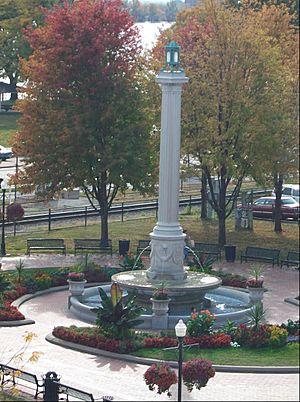John Forrest Dillon facts for kids
Quick facts for kids
John Forrest Dillon
|
|
|---|---|

John Dillon
|
|
| Born | December 25, 1831 |
| Died | May 6, 1914 (aged 82) |
| Nationality | United States |
| Occupation | lawyer, judge, professor |
| Known for | Dillon Rule |
John Forrest Dillon (December 25, 1831 – May 6, 1914) was an important American judge. He worked in both the national (federal) court system and the state courts in Iowa. He is famous for writing a very important book about how much power states have over local governments, like cities and towns. This idea is still known today as the "Dillon Rule."
Contents
Becoming a Judge: Early Life and Career
John Dillon was born on December 25, 1831, in Northampton, Montgomery County, New York. When he was 19, he started studying medicine at the University of Iowa.
Soon after working as a doctor, he decided to change his career. He started studying law instead. In 1852, he passed his exams and became a lawyer in Iowa.
- In 1853, he worked briefly as a private lawyer.
- Later that year, he was elected as the prosecutor for Scott County. A prosecutor is a lawyer who works for the government to bring cases against people accused of crimes.
- In 1858, he was elected to be a judge in Iowa's 7th Judicial Circuit.
- In 1862, he joined the Iowa Supreme Court, which is the highest court in the state of Iowa. He served there until 1869.
Working as a Federal Judge and Writing Books
In 1869, President Grant chose John Dillon to be a judge for the United States Circuit Court. This was a federal court, meaning it handled cases that involved national laws.
While he was a federal judge, Dillon wrote a very important book called Municipal Corporations in 1872. This was one of the first books to explain how local governments work. People still study it today! He also wrote two other books in 1876:
- Removal of Cases from State Courts to Federal Courts
- Municipal Bonds
After leaving the federal court, Dillon became a professor. He taught at Columbia Law School from 1879 to 1882. There, he taught about real estate (land and buildings) and equity (a type of fairness in law). He also taught at Yale Law School from 1891 to 1892. While at Yale, he was the president of the American Bar Association, a big group for lawyers.
John Dillon then went back to working as a private lawyer until he passed away in 1914 in New York City.
In 1918, a special fountain was built in downtown Davenport, Iowa, to remember John Dillon. It was carved from Indiana limestone and designed in a Romanesque style.
Understanding the Dillon Rule
John Dillon is most famous for an idea called the "Dillon Rule." This rule explains how much power local governments (like cities and towns) have compared to state governments.
In 1868, in a case called Clinton v Cedar Rapids and the Missouri River Railroad, Dillon wrote: "Municipal corporations owe their origin to, and derive their powers and rights wholly from, the legislature." This means that local governments get all their power from the state government. The state creates them, and the state can also change or even get rid of them.
In his book Municipal Corporations (1872), Dillon explained this idea more clearly. He said that states have a lot of power, but local governments only have the powers that the state legislature (the state's law-making body) clearly gives them.
The Dillon Rule says that local governments only have three types of powers:
- Powers that are clearly written down and given to them by the state legislature.
- Powers that are absolutely necessary for them to use the powers that were clearly given.
- Powers that are essential for the local government to exist and work.
If a law about a local government's power is not clear, courts should usually assume that the state did not mean to give that power. This means that local governments must be very careful to only do what the state laws allow them to do.
Hundreds of court decisions in the United States have used the Dillon Rule to decide what local governments can and cannot do.
Some people don't like the Dillon Rule. They say it makes it hard for communities to govern themselves and can hurt democracy. They believe that local self-government should be a basic right, not something that a higher government gives.
It's thought that Dillon's idea came from the belief at the time that cities had problems with corruption. During his time, there were many cases of corruption, especially because cities and their leaders were often involved in big businesses.
Today, most states in the United States still follow the Dillon Rule. This is true even though most people no longer think that cities have widespread corruption problems.
The Supreme Court of the United States (the highest court in the country) agreed with Dillon's ideas. In cases like Merrill v. Monticello (1891) and Hunter v. Pittsburgh (1907), the Supreme Court said that states have the power to change or even get rid of local government charters (their founding documents). For example, in Hunter v. Pittsburgh, the Court allowed Pennsylvania to combine the city of Allegheny into Pittsburgh, even though most Allegheny residents wanted to stay separate.
Images for kids
-
The Dillon Family monument in Oakdale Memorial Gardens in Davenport, Iowa where Dillon is buried.



